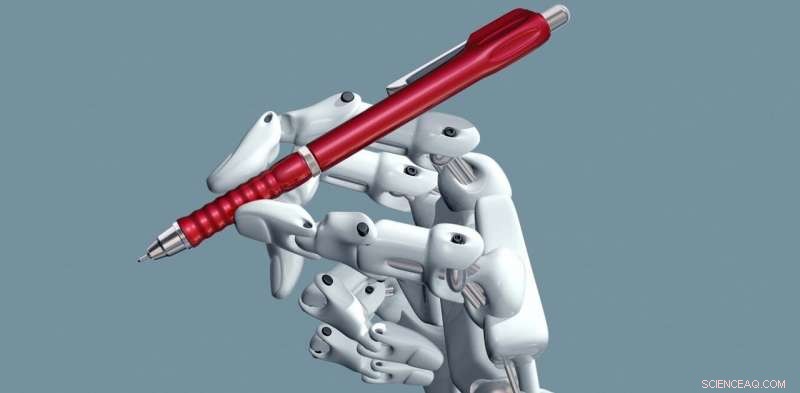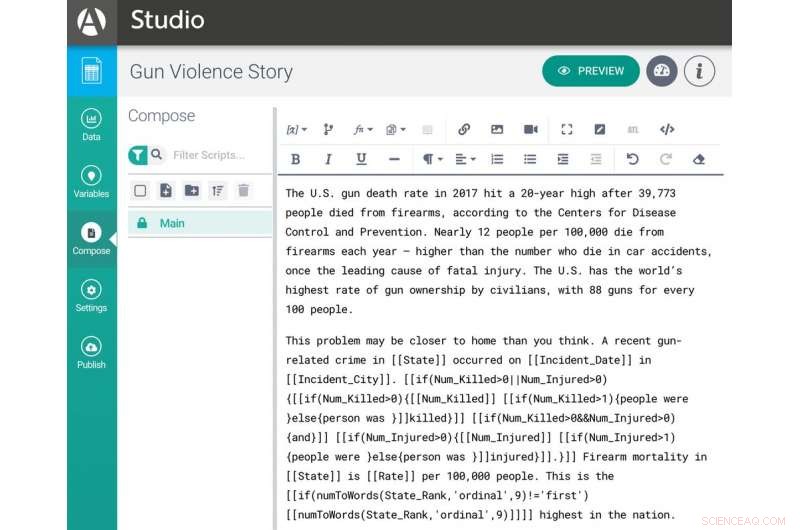
Os robôs ainda não seguram as canetas, mas podem ajudar as pessoas a fazer o trabalho. Crédito:Paul Fleet / Shutterstock.com
Assim como os robôs transformaram setores inteiros da economia de manufatura, inteligência artificial e automação agora estão mudando o trabalho de informação, permitindo que os humanos descarreguem o trabalho cognitivo nos computadores. No jornalismo, por exemplo, sistemas de mineração de dados alertam os repórteres sobre possíveis notícias, enquanto os newsbots oferecem novas maneiras para o público explorar as informações. Os sistemas de escrita automatizados geram dados financeiros, cobertura esportiva e eleitoral.
Uma pergunta comum à medida que essas tecnologias inteligentes se infiltram em vários setores é como o trabalho e a mão de obra serão afetados. Nesse caso, quem - ou o que - fará jornalismo neste mundo automatizado e aprimorado com IA, e como eles farão isso?
A evidência que reuni em meu novo livro "Automating the New:How Algorithms are Rewriting the Media" sugere que o futuro do jornalismo habilitado para IA ainda terá muitas pessoas por perto. Contudo, os trabalhos, papéis e tarefas dessas pessoas irão evoluir e parecer um pouco diferentes. O trabalho humano será hibridizado - combinado com algoritmos - para se adequar às capacidades da IA e acomodar suas limitações.
Aumentando, não substituindo
Algumas estimativas sugerem que os níveis atuais de tecnologia de IA poderiam automatizar apenas cerca de 15% do trabalho de um repórter e 9% do trabalho de um editor. Os seres humanos ainda têm uma vantagem sobre a IA que não é de Hollywood em várias áreas essenciais para o jornalismo, incluindo comunicação complexa, pensamento de especialista, adaptabilidade e criatividade.
Comunicando, ouvindo, respondendo e empurrando de volta, negociando com fontes, e ter a criatividade para montá-lo - a IA não pode fazer nenhuma dessas tarefas jornalísticas indispensáveis. Muitas vezes, pode aumentar o trabalho humano, no entanto, para ajudar as pessoas a trabalharem mais rápido ou com qualidade aprimorada. E pode criar novas oportunidades para aprofundar a cobertura de notícias e torná-la mais personalizada para um leitor ou telespectador individual.
O trabalho da redação sempre se adaptou às ondas de novas tecnologias, incluindo fotografia, telefones, computadores - ou mesmo apenas a copiadora. Os jornalistas vão se adaptar para trabalhar com IA, também. Como tecnologia, já é e continuará a mudar o trabalho jornalístico, frequentemente complementando, mas raramente substituindo, um jornalista treinado.
Novo trabalho
Eu descobri que na maioria das vezes, As tecnologias de IA parecem realmente estar criando novos tipos de trabalho no jornalismo.
Tomemos, por exemplo, a Associated Press, que em 2017 introduziu o uso de técnicas de IA de visão computacional para rotular as milhares de fotos de notícias que lida todos os dias. O sistema pode marcar fotos com informações sobre o que ou quem está em uma imagem, seu estilo fotográfico, e se uma imagem representa violência gráfica.
O sistema dá aos editores de fotos mais tempo para pensar sobre o que devem publicar e os libera de gastar muito tempo apenas rotulando o que possuem. Mas desenvolvê-lo deu muito trabalho, editorial e técnico:os editores tiveram que descobrir o que marcar e se os algoritmos estavam à altura da tarefa, em seguida, desenvolva novos conjuntos de dados de teste para avaliar o desempenho. Quando tudo isso foi feito, eles ainda tinham que supervisionar o sistema, aprovando manualmente as tags sugeridas para cada imagem para garantir alta precisão.

A interface de usuário do Arria Studio mostrando a composição de uma história personalizada sobre violência armada. Crédito:captura de tela de Nicholas Diakopoulos do Arria Studio, CC BY-ND
Stuart Myles, o executivo da AP que supervisiona o projeto, me disse que demorou cerca de 36 pessoas-mês de trabalho, espalhados por alguns anos e mais de uma dúzia de editoriais, pessoal técnico e administrativo. Cerca de um terço do trabalho, ele me disse, involved journalistic expertise and judgment that is especially hard to automate. While some of the human supervision may be reduced in the future, he thinks that people will still need to do ongoing editorial work as the system evolves and expands.
Semi-automated content production
No Reino Unido, the RADAR project semi-automatically pumps out around 8, 000 localized news articles per month. The system relies on a stable of six journalists who find government data sets tabulated by geographic area, identify interesting and newsworthy angles, and then develop those ideas into data-driven templates. The templates encode how to automatically tailor bits of the text to the geographic locations identified in the data. Por exemplo, a story could talk about aging populations across Britain, and show readers in Luton how their community is changing, with different localized statistics for Bristol. The stories then go out by wire service to local media who choose which to publish.
The approach marries journalists and automation into an effective and productive process. The journalists use their expertise and communication skills to lay out options for storylines the data might follow. They also talk to sources to gather national context, and write the template. The automation then acts as a production assistant, adapting the text for different locations.
RADAR journalists use a tool called Arria Studio, which offers a glimpse of what writing automated content looks like in practice. It's really just a more complex interface for word processing. The author writes fragments of text controlled by data-driven if-then-else rules. Por exemplo, in an earthquake report you might want a different adjective to talk about a quake that is magnitude 8 than one that is magnitude 3. So you'd have a rule like, IF magnitude> 7 THEN text ="strong earthquake, " ELSE IF magnitude <4 THEN text ="minor earthquake." Tools like Arria also contain linguistic functionality to automatically conjugate verbs or decline nouns, making it easier to work with bits of text that need to change based on data.
Authoring interfaces like Arria allow people to do what they're good at:logically structuring compelling storylines and crafting creative, nonrepetitive text. But they also require some new ways of thinking about writing. Por exemplo, template writers need to approach a story with an understanding of what the available data could say—to imagine how the data could give rise to different angles and stories, and delineate the logic to drive those variations.
Supervision, management or what journalists might call "editing" of automated content systems are also increasingly occupying people in the newsroom. Maintaining quality and accuracy is of the utmost concern in journalism.
RADAR has developed a three-stage quality assurance process. Primeiro, a journalist will read a sample of all of the articles produced. Then another journalist traces claims in the story back to their original data source. As a third check, an editor will go through the logic of the template to try to spot any errors or omissions. It's almost like the work a team of software engineers might do in debugging a script—and it's all work humans must do, to ensure the automation is doing its job accurately.
Developing human resources
Initiatives like those at the Associated Press and at RADAR demonstrate that AI and automation are far from destroying jobs in journalism. They're creating new work—as well as changing existing jobs. The journalists of tomorrow will need to be trained to design, atualizar, tweak, validate, correct, supervise and generally maintain these systems. Many may need skills for working with data and formal logical thinking to act on that data. Fluency with the basics of computer programming wouldn't hurt either.
As these new jobs evolve, it will be important to ensure they're good jobs—that people don't just become cogs in a much larger machine process. Managers and designers of this new hybrid labor will need to consider the human concerns of autonomy, effectiveness and usability. But I'm optimistic that focusing on the human experience in these systems will allow journalists to flourish, and society to reap the rewards of speed, breadth of coverage and increased quality that AI and automation can offer.
Este artigo foi republicado de The Conversation sob uma licença Creative Commons. Leia o artigo original. 